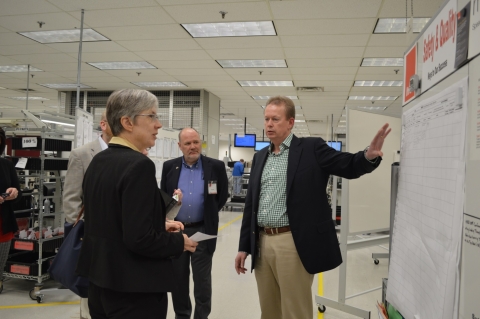Mar182015
Posted at 2:29 PM
Post by Dr. Sue Helper Chief Economist
It’s springtime, and during this season of growth and renewal another important renaissance is underway: a remarkable resurgence in American manufacturing. Powering this growth are the small- and medium-sized businesses that comprise the U.S. manufacturing supply chain.
President Obama in his State of the Union address earlier this year committed to supporting these small businesses. This week, in Cleveland, OH, he made good on that promise, announcing a series of key manufacturing initiatives. Additionally, a new White House-Department of Commerce report was released that examines the importance of reinvesting in America’s supply chain to enable innovation. The report, “Supply Chain Innovation: Strengthening America’s Small Manufacturers,” identifies potential barriers as well as solutions – laying the path toward sustained manufacturing growth and strength, at home and abroad, now and into the future.
As described in our report, the resurgence in manufacturing has seen the addition of 877,000 jobs added since February 2010. Small firms play an increasingly important role in U.S. manufacturing, and now account for almost half of America’s manufacturing employment. Dense networks of these small manufacturers are vital to the process of taking a product from concept to market, and sharing manufacturing expertise along the supply chain is essential for the diffusion of the new products and innovative processes that give U.S. manufacturing its cutting edge.
However, these small firms face barriers to innovation, a key element in strengthening U.S. competitiveness. While firms with fewer than 500 employees comprise 98 percent of all manufacturing firms, together they account for less than one-third of private-sector research and development (R&D) spending in manufacturing. And because of these barriers to innovation, in their operations, small manufacturers are less than 60 percent as productive as their larger peers. Moreover, lack of innovative capability impacts small suppliers’ customers: the quality of end products is compromised and it takes longer for innovative technologies to get to market.
Customer firms have a critical role to play in cultivating the capabilities of small firms in their supply chains and encouraging fruitful cross-pollination of expertise across firms. However, larger firms often under-invest in their suppliers because they fear improvements they pay for may end up benefitting their competitors, and because of conflicting internal goals.
Based on their experience in production, suppliers have potentially valuable knowledge about how to improve product design. However, their customers may not reap the benefit of this knowledge because of limitations of suppliers’ resources (financial, managerial, and technological). For example, less than one-third of small auto suppliers engaged in “value analysis”, a proven technique for joint problem-solving.
Public policy and the initiatives announced by the President this week can make an enormous difference. The government can catalyze buyers and suppliers toward realizing synergies in supply chains, by diffusing best practices in operations and procurement, improving access to resources needed for innovation, and by fostering discussion along the supply chain regarding common problems and opportunities.
Restoring the vitality of America’s supply chains and the small manufacturers at their core is essential to the future of U.S. manufacturing. The Administration’s focus on reinvesting in America’s small manufacturers is just one example of how public-private sector efforts can strengthen the foundation of these key elements of the U.S. economy. Indeed, the White House Supply Chain Innovation Initiative will focus on public-private partnerships and new federal efforts to strengthen U.S. manufacturing by closing this gap. Later this year, the Administration will convene a Supply Chain Innovation Roundtable of CEOs and representatives of leading manufacturers committed to partnering with the small businesses in their supply chains to accelerate technology adoption, strengthen the linkages within domestic supply chains, and to improve product design and process engineering. In addition, the Departments of Commerce, Energy, and Defense, as well as the Small Business Administration, will announce additional federal efforts to help small firms adopt cutting-edge technologies and improve information flow within supply chains.
Now is the time for additional action to build on these efforts and strengthen our manufacturing base. The good news is that ample opportunities exist for government at all levels to partner with the private sector to promote supply chain innovation and thus foster a continued manufacturing renaissance, now and into the future.
Like manufacturing, report writing is a team effort. I was lucky to be involved with a great team in writing the Supply Chain Innovation report and I want to acknowledge the important analytic and editorial contributions of the following staff: Jane Callen, Claire Monteiro, Jessica Nicholson, Ryan Noonan, Jessica (JJ) Raynor and Robert Rubinovitz. Thank you also to K.C. Pond for enormous assistance ensuring the report was posted on line, on time.


